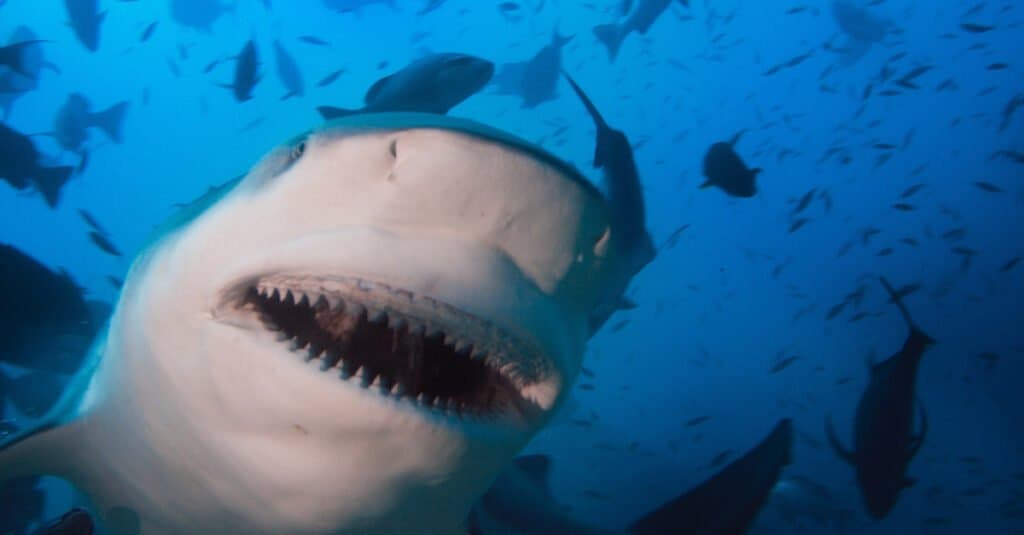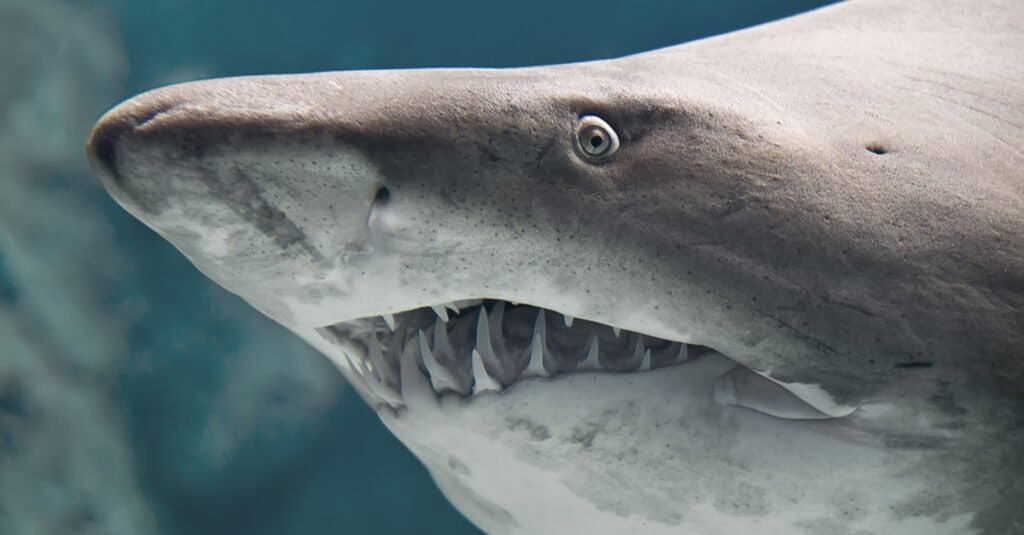When you think about dangerous and aggressive sharks, perhaps the first ones to pop up in your mind are the great white sharks, hammerhead sharks, and tiger sharks. While all these shark species are notoriously dangerous, one specific shark stands out above them all –the bull shark. Bull sharks can be extremely aggressive and dangerous, not to mention huge, measuring up to 11 feet, and have formidable jaw strength. Yet, what makes them more terrifying is their set of teeth. While most sharks share the same dental structure, bull sharks have more needle-like teeth than average sharks, and these teeth help them bite and grip their prey before swallowing them whole.
Bull sharks are especially known for their ability to swim to extremely far bodies of water, and yes, that includes freshwater habitats! Bull sharks are one of few species that can live in freshwater areas for prolonged periods because their bodies don’t carry as much salt as other shark species. Out of more than 400 species of sharks, bull sharks swim at the top spots of the scariest species because they can be very unpredictable. Apart from their wide habitat choices, including freshwater areas, bull sharks are also notorious for being powerful and adept hunters, preying on large sea animals like dolphins, stingrays, and seals. With this hefty diet, the bull shark teeth are certainly a huge help.
What Kind of Teeth Do Bull Sharks Have?

Bull sharks have shiny triangular white teeth that pierce through animal meat like a blade.
©Willyam Bradberry/Shutterstock.com
Bull sharks have shiny white teeth that are triangular. They are narrow and needle-like, but they pierce through animal meat like a blade. The bull shark’s teeth may seem slender, but they have wide roots beyond the gums and are characterized by tiny serrations around its edges. Bull shark teeth are not as long as other shark species, such as the great whites’ teeth which can go over 6 inches long, but the bull shark’s teeth are very sharp, thin, and cut like paper. Bull shark teeth typically grow about one inch in length.
Unlike mammalian teeth characterized by three or four various types of teeth, bull sharks only have one type of incredibly sharp teeth but have hundreds of that type of teeth. The bull shark’s needle-like teeth are best in holding onto different types of prey. With a diet that consists mainly of animal meat, such as seals, fish, and dolphins, having long, sharp-edged teeth is a big help in their hunting prowess.
Bull sharks can often be mistaken for great white sharks. This is understandable, though, because if you are not a shark expert, you’ll most likely perceive them as similar in physical appearance. Apart from the differences in their bodies, including their size, snout shape, life span, and speed, the bull sharks are more likely to have been the inspiration for the famous shark film Jaws. Since the film features sharks attacking shallow, coastal waters, the featured sharks must have been bull sharks that inhabit the same areas. On the other hand, great white sharks only swim in open waters. This is also why bull sharks are dangerous –they can swim in shallow waters where there are people nearby.
How Many Teeth Do Bull Sharks Have?

Bull sharks have at least 350 teeth.
©Havoc/Shutterstock.com
What makes bull sharks stand out from other shark species is their numerous teeth which are more than the average number of typical shark teeth. Sharks normally have 50 to 300 serrated teeth at a time, but bull sharks can have a total of 350 teeth and even more! While most shark species typically have 5 to 15 rows of sharp teeth lining their upper and lower jaws, bull sharks have 50 rows of teeth with seven teeth in each row. So once they open their mouths, expect to see what seems to be countless glossy white needles protruding from both of their jaws.
However, what’s more interesting about bull shark teeth is that their teeth continue to shed and grow back throughout their lives like any other shark species. Once an old tooth falls out, another one will surely erupt in its place. Bull sharks are polyphyodont, which means they continuously lose and grow back their teeth. They can have a minimum of 350 needle-like teeth in one set, and in one lifetime, they can grow and lose up to 20,000 teeth.
What Do Bull Sharks Use Their Teeth For?
Bull sharks are powerful predators, adept hunters, and opportunistic feeders in wherever habitat they settle in. They use their sharp, needle-like teeth to catch prey such as fish, sea turtles, birds, seals, and other marine animals. Unlike other animals that chew and grind their prey, bull sharks only use their hundreds of needle-sharp teeth in gripping onto their victims, then swallowing them whole afterward.
How Strong is a Bull Shark’s Bite?
Despite their smaller size, bull sharks have a pretty strong bite force. Bull sharks easily rank among the strongest shark bite forces with a bite force that goes up to 1,350 pounds per square inch (PSI) or 5,914 Newtons.
Since bull sharks usually swim upriver and live in freshwater habitats, they are likely to encounter crocodiles along the way. Crocodiles are by far one of the largest threats to bull sharks, given their massive size and powerful, over-the-top bite force. Apart from crocodiles, bull sharks can also encounter hippopotamus in rivers, and they may even deliberately hunt for the mammal’s young.
Do Bull Sharks Attack Humans?

Humans are naturally not on a bull shark’s menu.
©wildestanimal/Shutterstock.com
Humans are not really on the bull shark menu. However, rare attacks occur, especially in shallow, coastal waters where they typically reside. As bull sharks love to swim in parts of the ocean and rivers with significantly higher chances of human encounter, they can sometimes attack humans on a simple territorial urge or curiosity. Yet, since humans are not natural prey for bull sharks, they are more likely to swim away upon initial attack after realizing that humans are not part of their diet.
The photo featured at the top of this post is © Havoc/Shutterstock.com
Thank you for reading! Have some feedback for us? Contact the AZ Animals editorial team.






